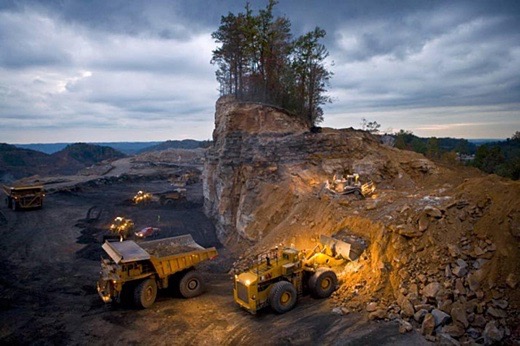SUBHEAD: Point of no Return - Carbon dioxide output will not drop below 400ppm in our lifetimes.
By Nadia Prupis on 30 September 2016 for Common Dreams -
(http://www.commondreams.org/news/2016/09/29/point-no-return-earth-reaches-400ppm-threshold-permanently)

Image above: Mountain top removal - Coal strip mining operations work around the clock at amazing speed; this lonely stand of trees disappeared in barely a day. The small bulldozer on the upper level pushes loose material down to the loader, which scoops it up into the next earth mover in line which will dump it into a nearby "valley fill," burying the stream there. From (http://jhenryfair.com/aerial/portfolio/mtr.html).
.
By Nadia Prupis on 30 September 2016 for Common Dreams -
(http://www.commondreams.org/news/2016/09/29/point-no-return-earth-reaches-400ppm-threshold-permanently)

Image above: Mountain top removal - Coal strip mining operations work around the clock at amazing speed; this lonely stand of trees disappeared in barely a day. The small bulldozer on the upper level pushes loose material down to the loader, which scoops it up into the next earth mover in line which will dump it into a nearby "valley fill," burying the stream there. From (http://jhenryfair.com/aerial/portfolio/mtr.html).
September's
carbon dioxide output failed to drop below 400 parts per million (ppm)
despite historically being the year's low point for CO2 emissions, which
means the Earth has very likely passed that symbolic climate threshold
forever.
The Earth has hit 400ppm before, but seasonal cycles have always reduced carbon dioxide output back below that level. Now, climate scientists say it is "almost impossible" that will ever happen again.
According to Climate Central:
"Brief excursions towards lower values are still possible but it already seems safe to conclude that we won't be seeing a monthly value below 400 ppm this year—or ever again for the indefinite future."
Climate Central continues:
Another recent report also found that the planet could pass another point of no return—the agreed-upon 1.5°C warming threshold—in a decade.
See also:
Ea O Ka Aina: Too Little - Too Late 12/23/15
At COP21 the world’s nations tried to limit the rate at which the greenhouse gases will increase in the future.
The Earth has hit 400ppm before, but seasonal cycles have always reduced carbon dioxide output back below that level. Now, climate scientists say it is "almost impossible" that will ever happen again.
According to Climate Central:
September is usually the month when carbon dioxide is at its lowest after a summer of plants growing and sucking it up in the northern hemisphere. As fall wears on, those plants lose their leaves, which in turn decompose, releasing the stored carbon dioxide back into the atmosphere. At Mauna Loa Observatory, the world's marquee site for monitoring carbon dioxide, there are signs that the process has begun but levels have remained above 400 ppm."Is it possible that October 2016 will yield a lower monthly value than September and dip below 400 ppm? Almost impossible," scientist Ralph Keeling, who runs the carbon dioxide monitoring program at the Scripps Institute for Oceanography, wrote in a blog post this week.
"Brief excursions towards lower values are still possible but it already seems safe to conclude that we won't be seeing a monthly value below 400 ppm this year—or ever again for the indefinite future."
Climate Central continues:
We may get a day or two reprieve in the next month, similar to August when Tropical Storm Madeline blew by Hawaii and knocked carbon dioxide below 400 ppm for a day. But otherwise, we're living in a 400 ppm world. Even if the world stopped emitting carbon dioxide tomorrow, what has already put in the atmosphere will linger for many decades to come.The confirmation comes soon after a report from the U.K. Met Office in June warned that the planet was well on its way toward that grim milestone as the impact from rising fossil fuel emissions was worsened by a turbulent El Niño event. Similar predictions came in May as climate scientists cautioned the limit could be hit at any time.
"At best (in that scenario), one might expect a balance in the near term and so CO2 levels probably wouldn't change much—but would start to fall off in a decade or so," Gavin Schmidt, NASA's chief climate scientist, said in an email. "In my opinion, we won't ever see a month below 400 ppm."
Another recent report also found that the planet could pass another point of no return—the agreed-upon 1.5°C warming threshold—in a decade.
See also:
Ea O Ka Aina: Too Little - Too Late 12/23/15
At COP21 the world’s nations tried to limit the rate at which the greenhouse gases will increase in the future.
.
No comments :
Post a Comment